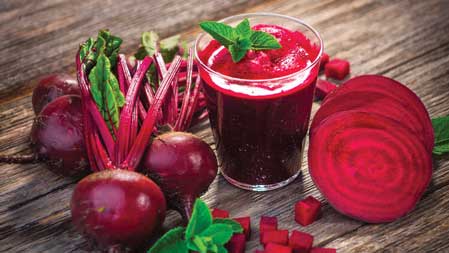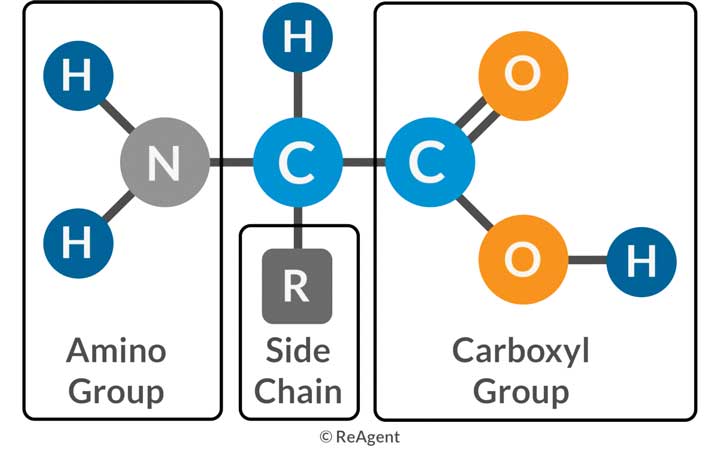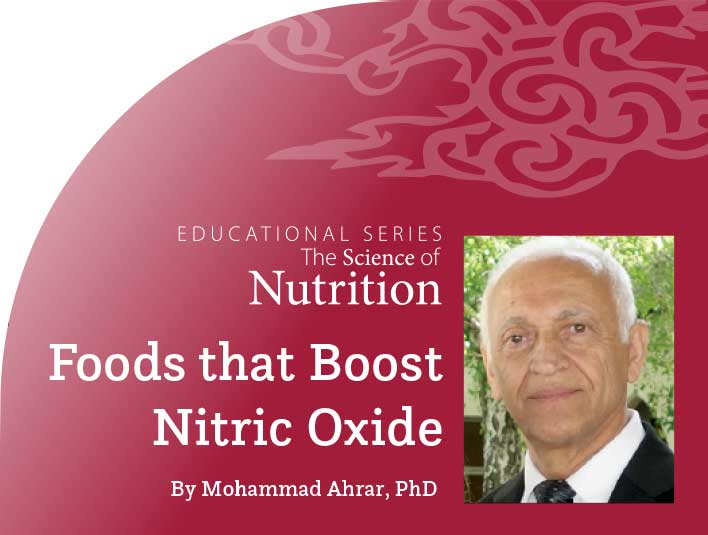Educational Series
The Science of Nutrition
Foods that Boost Nitric Oxide
By Mohammad Ahrar, PhD
Introduction
We usually don’t hear about chemicals that are not found in food, but are instead produced in the body—nitric oxide (NO) is one of them. Nitric oxide plays a major role in the proper function of many tissues and organs of the body. In this article, we will briefly discuss the importance of nitric oxide in the human body and its relation to the food that we eat.

How is Nitric Oxide Made in the Body?
Although nitric oxide is not a nutrient that we normally find in food, it is produced from nutrients in foods that contain nitrogen. Nitric oxide is naturally synthesized in the body from amino acids found in consumed proteins. When proteins are digested, they are broken down into amino acids which contain nitrogen. As amino acids are absorbed in the gastrointestinal tract, their nitrogen component is metabolized in the body to form nitrates and other nitrogenous compounds including nitric oxide.
Of the 23 amino acids found in nature, twenty are used for protein synthesis, including L-Arginine. L-Citrulline, which will be discussed below, is one of only three amino acids that is not used for protein synthesis. Each amino acid contains a nitrogen base called amine group (-NH2) and an acid group (-COOH), hence the name amino acid. The basic formula for an amino acid is shown below.
When amino acids are absorbed from the digestive tract, they are transported into the liver via the hepatic portal vein and metabolized by different enzymes in the liver cells. Most amino acids are assembled in the liver cells to make a variety of proteins such as plasma proteins and hemoglobin. Other amino acids will be deaminated to produce nitrate and other nitrogenous compounds.
Amino acids L-Arginine and L-Citrulline are the major contributors for the synthesis of nitrates and nitric oxide.
Nitric oxide can be synthesized endogenously in two ways—by a reduction of inorganic nitrate or through an enzyme action that converts 4-carbon L-Arginine to 3-carbon L-Citrulline. Nitric oxide can also be produced in different tissues in the body such as the lining of blood vessels and neural tissues. It is also produced by the bacteria in the mouth and concentrates in the saliva. The longer food stays in the mouth, the more nitric oxide is produced.

Major Roles of Nitric Oxide in the Body
Nitric oxide plays a major role in the regulation and functions of many organs and tissues even though it is technically a free radical.
Cardiovascular System Studies have shown that nitric oxide is involved in blood vessel dilation to allow oxygenated blood to reach tissues and cells in the body. (1) This can improve blood pressure, reduce arterial stiffness, and improve blood flow in the carotid artery. Nitric oxide is involved in inhibition of platelet aggregation that is responsible for blood clotting. This information may suggest that nitric oxide is a crucial factor in the prevention of cardiovascular damage such as that seen in atherosclerosis.
Erectile Dysfunction As nitric oxide increases blood flow, it has been studied for help with erectile dysfunction. Some published studies show that supplementation with nitric oxide may reduce erectile dysfunction in mild to moderate cases. (2) This is due to the fact that nitric oxide activates the relaxation of smooth muscle tissue in the male genital, which results in the increase of blood flow into the organ.
Immune System The immune system consists of many varieties of cells, such as T-lymphocytes. Nitric oxide helps these cells communicate with other immune cells and react more quickly to invading pathogens.
Muscle Performance Nitric oxide can increase oxygen delivery to the muscles. This could enhance athletic performance and reduce soreness after workouts. It has also shown that muscle protein synthesis was increased by 25% in healthy volunteers after three days on a relatively low-protein diet by adding L-Citrulline in the diet. (2)
Memory and Learning Nitric oxide improves memory by better storing and retrieving memories, and helping brain cells communicate quicker.

What Foods Enhance Nitric Oxide Production in the Body?
As nitrates can be converted into healthy nitric oxide, eating foods high in natural nitrates can help you improve your nitric oxide levels. Examples of foods that are high in nitrates or produce nitrates are listed below.
Spinach Of all most commonly eaten plants, spinach has the most impressive nitrate content. A single hundred-gram serving of spinach can contain anywhere from 24 to 387 milligrams of nitrates. When spinach is digested and metabolized, the nitrate can be converted to nitric oxide.
Bok Choy Like spinach, bok choy is a leafy green that is rich in nitrates. Depending on its growing conditions, a head of bok choy can contain anywhere from 103 to 309 milligrams of nitrates per hundred grams of vegetable matter.
Carrots If you prefer your vegetables in root form, then carrots can give you the nitrates you need. A hundred-gram serving of carrots can contain between 92 to 195 milligrams of nitrates.
Mustard Greens Another great, leafy source of nitrates is mustard greens. These flavorful greens have between 70 and 95 milligrams of nitrates per hundred-gram serving, making them one of the most consistent vegetable sources of nitrates.
Coleslaw Cabbage is an excellent source of nitrates. Coleslaw contains an average of about 55 milligrams of nitrates per hundred-gram serving.
Broccoli Broccoli comes in a little lower than leafier vegetables, but it still holds its own when it comes to nitrate content. A hundred gram serving of broccoli contains about 39.5 milligrams of nitrates that can be converted into nitric oxide.
Eggplant If you want to get your nitrates as a main dish instead of as a side, eggplant is a respectable source of nitrates. It can provide between 25 and 42 milligrams of nitrates per hundred-gram serving.
Garlic Garlic seems to be a potent method for improving your body’s manufacturing of nitric oxide and help the body use the nitrate more effectively.
Citrus Consuming citrus fruits boosts the amount of vitamin C in your body, which in turn improves your ability to absorb and react to nitric oxide.
Watermelon Watermelon is a great source of citrulline in the diet. The name citrulline comes from Citrullus lanatus, the scientific name for watermelon. The concentration of citrulline in watermelon depends on the type of cultivar and usually ranges between 0.7 and 3.6 g/kg of fresh weight. During watermelon development, there is a progressive accumulation of citrulline in its flesh and rind. Watermelons grown in arid areas with minimal water contain higher concentration of citrulline. Results of a study showed that consumption of wild watermelon-extracted juice reduces the stiffness of peripheral arteries, due to an increase in nitric oxide production. (3)
Beets Various studies involving beetroot juice have reported a significant increase in plasma nitrite levels, regarded as markers of nitric oxide, after intake of beetroot juice. (2)
Are Nitric Oxide Supplements Available?
Nitric oxide per se is not directly used as a supplement and is not usually found in stores. However, the precursors of nitric oxide, namely L-Arginine and L-Citrulline, are commercially produced and marketed. While you can find nitric oxide precursors as a supplement, it is more economical to get the nitric oxide you need by consuming a healthy diet and the natural food sources identified above.
Side Effects of Nitric Oxide
Too much of a good thing may not be so good and should be avoided, and nitric oxide is no exception. Excess or inappropriate production of nitric oxide can be equally as deleterious as insufficient nitric oxide. For example, L-Arginine supplements can cause side effects such as digestive discomfort. People taking L-Arginine supplements have complained of sour stomach and digestive discomfort. Nitric oxide supplementation may worsen certain health conditions and liver problems, and may interfere with certain medicines; therefore, it should only be taken under medical supervision. Obtaining nitric oxide from natural food sources is a better option for avoiding certain side effects.
Summary
Nitric oxide is not a nutrient that we normally find in foods, but it is produced from some nutrients in foods that contain nitrogen, naturally synthesized in the body. Nitric oxide plays a major role in the regulation and functions of many organs and tissues, and its components can be found in healthy, natural food sources.
Specific References
https://www.webmd.com/diet/healthy-foods-nitric-oxide
https://www.ncbi.nlm.nih.gov/pmc/articles/PMC9710401/
https://pubmed.ncbi.nlm.nih.gov/36558358/
General References
https://academic.oup.com/cardiovascres/article/43/3/521/317981
https://pubmed.ncbi.nlm.nih.gov/27019746/
https://www.mdpi.com/2076-3417/11/7/3293
Journal of Natural Health (Dec. 2016)

















